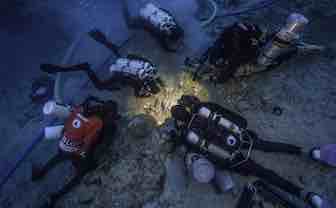By American Chemical Society —— Bio and Archives--April 29, 2020
 When a dead body is found, one of the first things a forensic pathologist tries to do is estimate the time of death. There are several ways to do this, including measuring body temperature or observing insect activity, but these methods don’t always work for corpses found in water. Now, researchers are reporting a mouse study in ACS’ Journal of Proteome Research showing that certain proteins in bones could be used for this determination.
An accurate estimate of when someone died can help investigators better understand what happened to the person and can help them identify possible murder suspects, if foul play was involved. However, determining the length of time a body has been underwater, or the post-mortem submerged interval (PMSI), can be very challenging. One way is to examine the decomposition stage of several areas of the body, but factors like water salinity, depth, tides, temperature, presence of bacteria and scavengers can make PMSI estimation difficult. But bones are stronger than soft tissues, and they lie deep within the body, so the proteins within them might be shielded from some of these effects. So, Noemi Procopio and colleagues wondered if monitoring the levels of certain proteins in bones could reveal the amount of time that a mouse’s corpse is underwater, and also whether different types of water mattered.
To find out, the researchers placed fresh mouse carcasses in bottles of tap water, saltwater, pond water or chlorinated water. After a PMSI of 1 or 3 weeks, the team collected the tibia, or lower leg bones, from the corpses, extracted the proteins and analyzed them by mass spectrometry. The researchers found that the time since submersion had a greater effect on protein levels than the different types of water. In particular, a protein called fructose-bisphosphate aldolase A decreased in bone with increasing PMSI. In pond water, a protein called fetuin-A was more likely to undergo a chemical modification, called deamidation, than in the other types of water, which could help reveal if a body was once submerged in pond water and then moved. These and other potential biomarkers identified in the study could be useful for PMSI estimation in different aquatic environments, the researchers say.
“Aquatic Decomposition of Mammalian Corpses: A Forensic Proteomic Approach”
When a dead body is found, one of the first things a forensic pathologist tries to do is estimate the time of death. There are several ways to do this, including measuring body temperature or observing insect activity, but these methods don’t always work for corpses found in water. Now, researchers are reporting a mouse study in ACS’ Journal of Proteome Research showing that certain proteins in bones could be used for this determination.
An accurate estimate of when someone died can help investigators better understand what happened to the person and can help them identify possible murder suspects, if foul play was involved. However, determining the length of time a body has been underwater, or the post-mortem submerged interval (PMSI), can be very challenging. One way is to examine the decomposition stage of several areas of the body, but factors like water salinity, depth, tides, temperature, presence of bacteria and scavengers can make PMSI estimation difficult. But bones are stronger than soft tissues, and they lie deep within the body, so the proteins within them might be shielded from some of these effects. So, Noemi Procopio and colleagues wondered if monitoring the levels of certain proteins in bones could reveal the amount of time that a mouse’s corpse is underwater, and also whether different types of water mattered.
To find out, the researchers placed fresh mouse carcasses in bottles of tap water, saltwater, pond water or chlorinated water. After a PMSI of 1 or 3 weeks, the team collected the tibia, or lower leg bones, from the corpses, extracted the proteins and analyzed them by mass spectrometry. The researchers found that the time since submersion had a greater effect on protein levels than the different types of water. In particular, a protein called fructose-bisphosphate aldolase A decreased in bone with increasing PMSI. In pond water, a protein called fetuin-A was more likely to undergo a chemical modification, called deamidation, than in the other types of water, which could help reveal if a body was once submerged in pond water and then moved. These and other potential biomarkers identified in the study could be useful for PMSI estimation in different aquatic environments, the researchers say.
“Aquatic Decomposition of Mammalian Corpses: A Forensic Proteomic Approach”
The Comment section of online publications is the new front in the ongoing Cancel Culture Battle.
Big Tech and Big Media are gunning for the Conservative Voice—through their Comment Sections.
Canada Free Press wishes to stay in the fight, and we want our fans, followers, commenters there with us.
We ask only that commenters keep it civil, keep it clean.
Thank You for your patience and for staying aboard the CFP ‘Mother Ship’.
READ OUR Commenting Policy